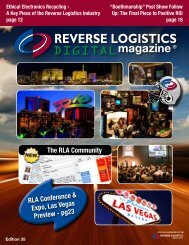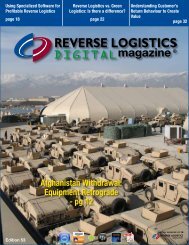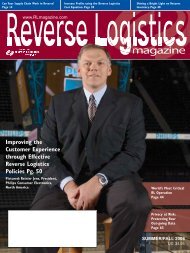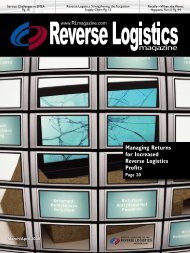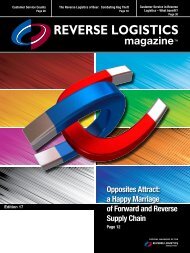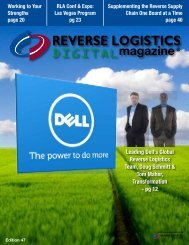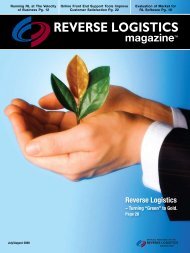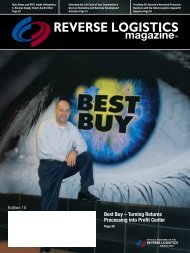Download - Reverse Logistics Magazine
Download - Reverse Logistics Magazine
Download - Reverse Logistics Magazine
You also want an ePaper? Increase the reach of your titles
YUMPU automatically turns print PDFs into web optimized ePapers that Google loves.
articles<br />
The Intelligent Supply Chain<br />
by John Borrelli<br />
The reverse supply chain function<br />
has fi lled an important role for<br />
manufacturers to control the fl ow<br />
of product returns back through the<br />
distribution channel. This function<br />
has become even more important<br />
in the technology space where<br />
the stakes are high, as grueling<br />
competition and razor-thin margins<br />
have already driven companies to<br />
squeeze every last dollar out of the<br />
manufacturing process. As these<br />
companies search for new ways<br />
to reduce their operating expense,<br />
many technology manufacturers<br />
still fi nd themselves grappling with<br />
stubborn ineffi ciencies embedded<br />
within their reverse supply chain.<br />
It is estimated that 70% to 85%<br />
of products returned through this<br />
channel have what is known as<br />
no trouble found (NTF), where<br />
materials are returned for reasons<br />
other than a product defect.<br />
However, amongst the advanced<br />
processes prevalent in today’s<br />
supply chain, which are primarily<br />
designed to minimize costs, there<br />
is not a well-defi ned focus on the<br />
timely repair, warranty evaluation,<br />
remarketing and intelligently<br />
reintroducing product back into<br />
the service supply chain.<br />
With the Aberdeen Group estimating<br />
that high-tech organizations<br />
spend approximately 8% of revenues<br />
on reverse logistics activities,<br />
there are new opportunities<br />
and techniques to intelligently<br />
manage product returns and reintroduce<br />
materials that pass a<br />
stringent testing and screening<br />
evaluation, back into the service<br />
supply chain. This process can<br />
not only introduce new cost saving<br />
opportunities throughout all<br />
levels of the supply chain, but also<br />
generate new revenue opportunities<br />
that can streamline the overall<br />
management of the reverse supply<br />
chain function.<br />
Supply Chain Deep Dive<br />
So what exactly is a reverse supply<br />
chain? In order to recognize<br />
potential ineffi ciencies as well as<br />
new revenue opportunities, we<br />
must fi rst understand the fl ow<br />
of products and the steps associated<br />
with an average supply chain<br />
model. In a typical forward supply<br />
chain, raw materials are procured<br />
from many different sources<br />
(original design manufacturers<br />
(ODMs), inventory, spot market,<br />
etc), assembled at a manufacturing<br />
facility and distributed to<br />
customers, retailers, resellers and<br />
wholesalers for fi nal sale. The<br />
forward supply chain is straightforward<br />
and has been the focus of<br />
many innovations and cost saving<br />
measures in the high technology<br />
industry.<br />
Forward Supply Chain<br />
Procurement<br />
12 <strong>Reverse</strong> <strong>Logistics</strong> <strong>Magazine</strong> • Edition 16<br />
Manufacturing Distribution<br />
In a reverse supply chain model,<br />
materials that are sold through the<br />
forward supply chain are received<br />
back at the point of purchase as<br />
“returns” for a number of reasons<br />
including wrong item, color,<br />
style, price, user issues, buyer<br />
remorse, defective product, etc.<br />
Materials received are then forced<br />
back through the forward supply<br />
chain channel to the manufacturer<br />
through their existing distribution<br />
network. In many instances,<br />
materials are accumulated at a<br />
processing center until a quantity<br />
large enough for cost effective<br />
processing is achieved. This<br />
accumulation could take place over<br />
several weeks to several months<br />
and is not the primary focus of the<br />
product support teams.<br />
With the average technologybased<br />
product life cycle<br />
measured in months, this method<br />
of accumulating product is<br />
very ineffi cient. With existing<br />
processes designed to save costs,<br />
the returned materials quickly lose<br />
potential value the longer they sit<br />
in storage waiting to be processed.<br />
In many instances, these materials<br />
are never screened to save costs.<br />
Because returns are the necessary<br />
evil of the supply chain, materials<br />
are usually sent directly for<br />
recycling to recover a small<br />
Customer<br />
Retailer/Reseller<br />
www.RLmagazine.com<br />
Sale<br />
percentage of their original cost<br />
through the recovery of intrinsic<br />
value or base materials, typically<br />
by weight. This ineffi cient method<br />
not only fails to reuse materials<br />
with NTF — an essential part of<br />
recycling, but loses the ability to<br />
process manufacturer warranty<br />
claims for full value recovery for<br />
defective materials.<br />
It is estimated that more than half<br />
of technology fi rms use a warranty<br />
claim processing system. However,<br />
these systems are primarily<br />
used for materials identifi ed as<br />
substandard in the forward supply<br />
chain. In most instances, materials<br />
that are received through the<br />
reverse supply chain remain<br />
under ODM warranty but lose<br />
precious processing time sitting<br />
idle in warehouse depots. The<br />
end result is the expiration of<br />
warranty periods and the value of<br />
components dramatically decline.<br />
Another area of the reverse supply<br />
chain where ineffi ciency is the<br />
most prevalent is found in the<br />
service supply function, where<br />
fi eld support and product returns<br />
are one of the most diffi cult<br />
reverse supply chain operations<br />
to streamline. Not only is an<br />
adequate inventory of replacement<br />
components needed to support<br />
these service repair calls, but the<br />
improper processing of materials<br />
returned back to the service depot<br />
from fi eld technicians can cost<br />
www.RLmagazine.com<br />
organizations millions each year.<br />
In this area, delays, shipping<br />
charges, warranty claims and<br />
administrative overhead cost<br />
drive the ineffi ciencies upward<br />
as material scrap and inventory<br />
management drain valuable<br />
resources.<br />
Intelligent Redeployment<br />
So where are the greatest opportunities<br />
to improve operational effi<br />
ciencies?<br />
Consider a typical scenario: A customer<br />
contacts the manufacturer,<br />
distributor or retailer for a warranty<br />
claim on their computer. The<br />
company dispatches a fi eld service<br />
technician to diagnose a potential<br />
memory problem with the users<br />
system. Components are pulled<br />
from service spare inventory and<br />
the fi eld support representative arrives<br />
at the customer’s business or<br />
residence with a service kit containing<br />
replacement components<br />
to troubleshoot the reported problem.<br />
For service calls, time is money<br />
and there’s not much time for<br />
troubleshooting. In most instances,<br />
it’s less expensive to simply<br />
replace suspect parts than to take<br />
the time to diagnose the problem.<br />
In this example, the customer’s<br />
problem may have been caused<br />
by one bad memory module out<br />
1 st International<br />
Forum for<br />
<strong>Reverse</strong> <strong>Logistics</strong><br />
in Brazil<br />
Bourbon Convention<br />
Ibirapuera<br />
Sao Paulo, Brazil<br />
May 13, 2009<br />
The CLRB – <strong>Reverse</strong> <strong>Logistics</strong><br />
Council of Brazil and the <strong>Logistics</strong><br />
<strong>Magazine</strong> Revista Tecnologística<br />
have organized the 1st International<br />
Forum for <strong>Reverse</strong> <strong>Logistics</strong> with<br />
the participation of the <strong>Reverse</strong><br />
<strong>Logistics</strong> Association.<br />
The forum will feature six reverse<br />
logistics case studies of major<br />
companies in various business<br />
sectors as well as presentations<br />
from national and international<br />
professionals focusing on relevant<br />
market data, company image,<br />
customer loyalty and socioenvironmental<br />
responsibility.<br />
www.clrb.com.br/forum/





